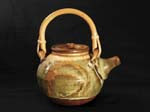Earlier in the month we completed our bisque firing. We fired in Seth's wood kiln rather than an electric kiln the way some wood firing potters do. If you remember, the bisque firing is the first firing a pot gets. This hardens or sinters* the greenware (raw clay) but leaves the pot porous enough to soak up glaze. (*To sinter means to heat the ceramic elements enough to fuse them together without vitrifying them.) We loaded the kiln over 2 days, moving steadily from the back of the chamber, building up pots and shelves. (As you will see in the pictures, my other master potter, Jennie, came to visit and was able to be there for the firing!)
We bisque fired to cone 05. "Cone" is the method by which potters measure temperatures. It is called "cone" because it is literally a cone that is placed upright in a small window inside the kiln and wilts down to a lovely curve when the desired temperature is reached. The temperature for cone 05 is 1800 - 1900 degrees Fahrenheit. (Seth's glaze kiln goes up to cone 10 or between 22oo - 2300 degrees F. At home in VA, Jennie and I glaze fire to cone 6 or between about 2265 - 2365 degrees F.)
The studio was overflowing with work, of mine and Seth's as well as some friend's and other student's work. Near midnight we lit a small fire in the fire box to begin the warming.
Setting my alarm for 2am and 4am, I stumbled down the hill and stairs to check the fire. At 2 it needed a little stoking (but not too much) and at 4 I had to relight it. The warming is to let any remaining moisture escape from the kiln before raising the temperature. Around 7:30 am Helen and Seth checked for steam coming out of the chimney and finding none began to raise the temp by stoking the fire.
We stoked for about 10 hours and at 5:30pm the cone had wilted and we were finished. The kiln over fired just in the last few hundred degrees but the work was fine and still porous.
We are now in the throws of decorating. Glaze firing set for November 11th!

